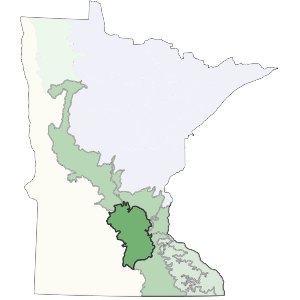This subsection coincides with a large block of deciduous forest present at the time of Euro-American settlement. West of the subsection, tallgrass prairie was the primary vegetation, suggesting basic differences in climate, topography, and natural disturbance. East of the subsection, savanna and tallgrass prairie communities reflect differences in topography and fire regimes, as well as parent material. To the north, the Mississippi River and a fairly extensive outwash and lake plain defines the boundary.Topography characteristically is gently to moderately rolling across this subsection. Soils are formed in thick deposits of gray limey glacial till left by the Des Moines lobe. Northern red oak, sugar maple, basswood, and American elm were most common in this dominantly forested region. Presently, most of the region is farmed.
Landform
The primary landform is a loamy mantled end moraine associated with the Des Moines lobe of the Late Wisconsin glaciation. Parts of the moraine have ice disintegration features. The dominant landscape feature is circular, level topped hills bounded by smooth side slopes. Broad level areas between the hills are interspersed with closed depressions containing lakes and peat bogs. Drainage is often controlled by the lake levels (Dept. of Soil Science, Univ. of Minn., 1973).


